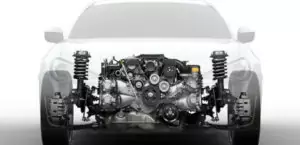The 1.4-liter Ford 1.4 TDCi or DLD-414 diesel engines were produced from 2002 to 2014 and were installed on models such as the Fiesta and Fusion, as well as on the Mazda 2 under the Y404 index. This diesel engine was created jointly with the Peugeot-Citroen concern and is completely similar to the Peugeot 1.4 HDi.
Ford 1.4 TDCi engine design
In 2002, the most compact 1.4-liter Ford diesel engine debuted on the Fiesta model. The unit was created as part of a joint venture with Peugeot-Citroen and has an analogue of the Peugeot 1.4 HDi. Briefly about the design of this motor: there is an aluminum cylinder block with cast-iron liners, an aluminum 8-valve head equipped with hydraulic lifters and a timing belt drive. Also, all versions are equipped with a Siemens Common Rail fuel system with a SID 802 or 804 high pressure fuel pump and a conventional BorgWarner KP35 turbocharger without variable geometry and without an intercooler.
In 2008, an updated 1.4 TDCi diesel engine appeared on the new generation of the Fiesta model, which, thanks to the start-stop system and a particulate filter, managed to be entered into Euro 5 environmental standards.
Specifications
| Production years | 2002-2014 |
| Displacement, cc | 1399 |
| Fuel system | Common Rail |
| Power output, hp | 68 – 70 |
| Torque output, Nm | 160 |
| Cylinder block | aluminum R4 |
| Block head | aluminum 8v |
| Cylinder bore, mm | 73.7 |
| Piston stroke, mm | 82 |
| Compression ratio | 17.9 |
| Hydraulic lifters | yes |
| Timing drive | belt |
| Fuel type | diesel |
| Euro standards | EURO 3/4 |
| Engine lifespan, km | ~300 000 |
In total, four modifications of such power units are found on Ford cars. And this diesel engine was installed on the Mazda 2 under its own index Y404.
| F6JA (68 hp / 160 Nm / Euro 3) | Ford Fiesta Mk5, Fusion Mk1 |
| F6JB (68 hp / 160 Nm / Euro 4) | Ford Fiesta Mk5, Fusion Mk1 |
| F6JD (70 hp / 160 Nm / Euro 4) | Ford Fiesta Mk6 |
| KVJA (70 hp / 160 Nm / Euro 5) | Ford Fiesta Mk6 |
| Y404 (68 hp / 160 Nm / Euro 3/4) | Mazda 2 DY, 2 DE |
Disadvantages of the Ford 1.4 TDCi engine
- The main problems of the owners here are related to the vagaries of the Siemens fuel system: most often the piezo injectors or the PCV and VCV control valves on the high pressure fuel pump fail. Also, this system is very afraid of airing, so it is better to keep a supply of fuel in the tank.
- On a run of over 100 – 150 thousand km, an impressive oil consumption is often encountered due to the destruction of the membrane of the crankcase ventilation system, which changes along with the valve cover. The cause of the oil burn can also be the critical wear of the cylinder-piston group.
- The remaining breakdowns are typical for many diesel engines and we will list them in a single list: refractory washers under the nozzles often burn out, the EGR valve quickly clogs, the crankshaft damper pulley does not serve well, and lubricant and antifreeze leaks often occur.






